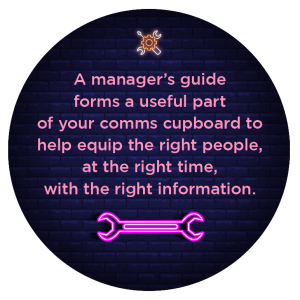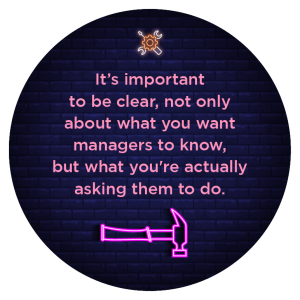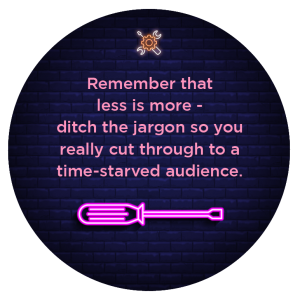Building IKEA furniture. It’s a chore, isn’t it?
Wandering the aisles, collecting up all the necessary parts so you don’t get home with your car boot rammed, only to have to return for those missed items. And all the while, you’re busy dreaming of meatballs, jam and creamy, creamy mash…
But isn’t it satisfying, when, after all that researching, planning, screwing, hammering, ramming and polishing, your fabulous new bookcase, chest of drawers or giant storage system is finally complete?
You’ve created something useful, practical and rather beautiful that you can be properly proud of. Not just for you, but for everybody else to make good use of too.
That’s how it should be when we’re creating resources for our managers. Pausing to properly research, plan and refine the content until it shines.
15 ways to create a beautiful yet practical guide
Whether our clients are launching a new set of values, sharing their corporate narrative, communicating a transformation programme or embedding new software across the business, a manager’s guide is useful as part of a ‘cupboard of comms’ to help equip and inform the right people, at the right time, with the right information.
We opt for IKEA because we love the way it looks, it’s convenient and the end product is both practical and smart. We think manager’s guides should be no different.
But you don’t need to take our word for it. We’ve asked three marvellous comms pros what they think is important when it comes to a top-notch manager’s guide:
-
Keep it compact
“Managers are bombarded with information and requests from all directions, so the reality is that communicators are competing for their attention in the same way as any other audience,” says Dave Wraith, Internal Comms, Employee Engagement and Change Communications Specialist. “You’re more likely to be successful by keeping manager’s guides as short as possible and laying them out in a visual, accessible way with easily digestible chunks of information.”
-
Help them develop a deeper understanding of the subject
“Manager’s guides should always point to a channel where they can ask questions or get further help and support,” adds Dave. “Use your guide to highlight the headlines and then signpost them to resources where they can develop a deeper, more informed understanding of the subject or related topics in their own time.”
-
Use stories to bring points to life
Illustrate your points with short stories and case studies to help bring them to life. Encourage line managers to do the same when they are sharing on to make their messages engaging and authentic.
-
Include the WHY, the WHAT and the HOW
“Unless people understand WHY you want them to do things differently, or carry out a specific activity, they’re unlikely to do it,” says Keren McCarron, Head of Corporate Affairs & Communications at KP Snacks. “The WHAT is the detail of what they need to do and the HOW is either the tool they can use to help them do it where to seek help.
An example at KP Snacks is that we’re working with Alive to create a booklet around a new 121 process which we’ll be rolling out to all managers in our factories. In the booklet we tell them WHY a regular, good quality 121 with their team members is important; we give them the details of WHAT the conversations should cover off; and we provide information on HOW they can find key documents or how to refer colleagues on to areas like the Employee Health and Wellbeing.”
-
Set expectations

“Managers are often very busy and they have to fit in the ‘doing’ of their day job, whilst also making sure they’re a good manager for their team. Some managers may need extra support in achieving this,” adds Keren.
“It’s important to be clear about what you’re asking managers to do. For example as part of our new 121 process, we’ve been clear about how frequently we expect managers to carry them out, factoring in that some people have bigger teams than others.”
-
Support it with a training session
“If you’re briefing out a new way of working or a specific toolkit, it may be worth running an awareness and training session with some or all of the managers who’ll be using it,” says Keren. “This can help you to address any queries they may have and make sure everyone understands why they need to be doing it and exactly what is expected of them.”
-
Feature simple yet powerful messages
According to Alex Mills, Corporate Communication Manager at South Yorkshire Fire and Rescue, “The key is the words or phrases you use which will flick a switch and empower your managers in a really practical, supportive way. Try to limit these messages to three or four per section – too many and people just won’t remember them.”
-
Include an intro from senior leadership
Ensure they know that they have support from above and that what they’re being asked to do has been fully endorsed by leaders. Teeing up your guide with a strong message from the CEO or suitably positioned leader can help to give it credibility and importance.
-
Use the power of the pause
Identify moments where the reader is encouraged to stop, think, reflect; considering the rationale for themselves to help them relate and find ownership in what they’re reading. Ask them, “How could you make this relevant to the people in your team?”
-
Be realistic
“Think about how things will work in your own context,” says Alex.
“It’s all very well asking your managers to do certain things, but if you wouldn’t act on them yourself in your own team then it’s inauthentic and won’t work.”
-
Consider your organisation’s unique sensitivities
“Know your organisation – what will go down well, and what will just switch people off. Make sure the case studies or ambassadors you use stand up to scrutiny too – only use people who truly represent your values and behaviours.”
-
Build in some basic comms skills
It’s understandable that managers may worry about how to actually communicate in the best way. Consider including some basic tips and reminders on general communication skills. Think about tips that will help them add value to their conversations, personalise things and listen as well as speak.
-
Drop in a question or two
Include examples of questions they may be asked from their teams about the subject, helping them to prepare and feel more confident about handling the issues that may come up. Drop them throughout the guide to help break it up and create moments of reflection.
-
Use simple, jargon-free language

“Plain English is important,” says Alex.
“Listing easy to understand, practical advice ideally in a step-by-step way is going to help hard-pressed managers to take the information on board. As is so often the case, less is more too – ditch the jargon and lose the waffle, so you really cut through to a time-starved audience.”
-
Maintain momentum
“Publishing a guide and expecting change to happen overnight is not job done,” adds Alex. “You will have to keep plugging away and finding creative ways to drop elements of the manager’s guide into every day communication and conversations.”
Apply this advice next time you’re creating content for your line manager’s guide and you’ll be well on your way to giving them the wonderful every day.
And if you need a little help screwing it all together, just drop us a line. We’re pretty nifty with an ‘Alan key’ too…
















